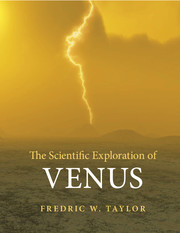Book contents
- Frontmatter
- Contents
- Overview
- Prologue
- A note on scientific units
- Acknowledgements
- Part I Views of Venus, from the beginning to the present day
- Part II The motivation to continue the quest
- Part III Plans and visions for the future
- Epilogue
- References and acknowledgements
- Appendix A Chronology of space missions to Venus
- Appendix B Data about Venus
- Index
- Plate section
Part III - Plans and visions for the future
Published online by Cambridge University Press: 05 September 2014
- Frontmatter
- Contents
- Overview
- Prologue
- A note on scientific units
- Acknowledgements
- Part I Views of Venus, from the beginning to the present day
- Part II The motivation to continue the quest
- Part III Plans and visions for the future
- Epilogue
- References and acknowledgements
- Appendix A Chronology of space missions to Venus
- Appendix B Data about Venus
- Index
- Plate section
Summary
Plans and visions for the future
The last American mission to Venus was in 1991 (Magellan), and the last from the Soviets in 1985 (Vega). Europe has its first spacecraft to the twin planet still operating in Venus orbit at the time of writing, having arrived there in 2006 (Venus Express), but so far the Europeans show little political will to follow up on this success. Japan still hopes to get something from its Akatsuki probe when it meets Venus again six years after its failed attempt to enter orbit in 2010. What happens next?
In seeking to answer that question, armed with a mass of unsolved scientific questions from Part II, we must enter the murky and uncertain world of politics, budgets and planning, or ‘programmatics’ as it is euphemistically called in the space agencies. We are helped by the long-term planning process operated by the scientists in their institutes and universities, by the learned societies and national academies, and by the agencies themselves. But these produce wish lists (usually called ‘roadmaps’ these days) and not real predictions. Even the most optimistic planetary scientist knows that most of what they plan will not be carried out. So what will?
- Type
- Chapter
- Information
- The Scientific Exploration of Venus , pp. 235 - 236Publisher: Cambridge University PressPrint publication year: 2014



